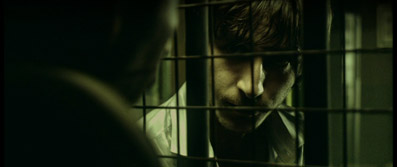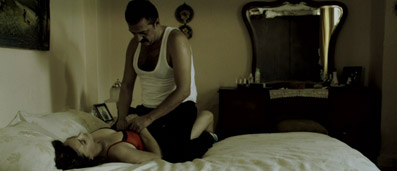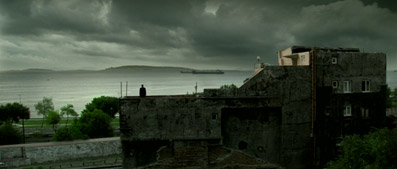| "So the idiots leave before the film starts." |
| Andrei Tarkovsky, when asked why his car traffic scene in Solaris was so long |
Three Monkeys [Üç maymun] opens with a close up of the face of Servet (Ercan Kesel), driving at night, the top button of his shirt undone and his tie loosened. His head rocks up and down intermittently and he blinks slowly, performing the necessary rituals to fight off sleep. Cut to the road, a tracking shot following the car from behind. The camera keeps up for a while, the headlights picking out overhead trees and the surrounding undergrowth, before letting the car drift off onto the horizon, leaving a speck of light in the distance before fading to black. When we fade back in, the car is approaching the camera. A dark figure, seeing headlights, flees to the side of the road out of sight. The car's lights pick out the outline of a body, lying prone in the middle of the road. It stops, we overhear some voices, then it speeds off again. As it passes, Servet pops his head up from the bottom of the frame where he's been hiding – the first of director Nuri Ceylan's many visual tricks.

This is a film that rewards concentration like no other. The story moves slowly like melting wax, seeing politician Servet, running for high office, panicking after his hit-and-run accident. He approaches his loyal driver Eyup (Yavuz Bingol) with an offer: do the time in return for a cash lump sum to be paid upon release from prison, and monthly payment's to Eyup's wife Hacer (Hatice Aslan) and son Ismail (Ahmet Rıfat Sungar). Eyup agrees. Ismail struggles to find a job but has vague aspirations to set up on his own, driving kids to school. When he gets into trouble with some local thugs, Hacer starts to fear for Ismail's safety. She approaches Servet to get an advance on the lump sum: leading to an illicit, implosive affair.
It seems like fairly straightforward stuff, and for the most part it is – the story doesn't have room for many characters other than the main four, and the film is devoid of any real sub-plots. Likewise the action is grounded in a small cache of locations, with much of the drama occurring in Eyup's flat. These are small concessions to the attention span however, as Three Monkeys actually turns out to be a highly complex, rewarding and at times infuriating cinematic experience, due in large part to the way it organizes its story. The film moves at a snail's pace, with lengthy scenes that take their time to end, or appear not to be necessary at all. The transitions between scenes are smudged, as if the director is finger painting on his celluloid strip. Time becomes malleable, lurching forward brutally – one transition has Ismail lying on his bed after a recent visit to Eyup, followed by a shot of father and son on the journey home from prison – months pass between the two shots with no warning or fanfare. Often these cuts are jarring, leaving the audience to piece together what has happened in the intervening space. We watch a door being opened by one character, only to see another in a new scene stepping through it. Sound often bleeds over between two scenes to such an extent that it is often difficult to determine which one it belongs to (mobile ringtones prove a particularly good tool for this kind of audible fuckery).

Ceylan relishes the long takes and the interrogative gaze of the camera – scenes are populated with minor details, some essential turning points in the plot, others are just the minutiae ticks, fidgets and trivialities of daily life. When Hacer returns from her first meeting with Servet, she plays with her right shoe idly before giving her son the good news, kicking it up into the air and giggling – a playful, everyday moment captured in the generous bracketing of the long take. In another, Ismail necks down a whisky at a party – again a trivial, everyday event but one which leads to much more serious dramatic consequences. These little nuances are the evidence given to the audience to solve the puzzles of the story; we never see Eyup agree to Servet's plan, but we do see him sitting at the foot of his bed holding a set of car keys. What could be dull and lifeless, as so often is the case with long take cinema, is here rendered serene, hypnotic and gripping – you're unable to disregard any tiny bit of business because it could have massive plot importance. The long takes also give the drama a much more realistic edge. One scene that has Eyup trying to sexually dominate his wife is excruciatingly uncomfortable as he keeps leaving, summoning up his anger and returning to her – his thick fingers wrapping around her exposed nipple and her obvious revulsion to his touch gets a magnified, heightened effectiveness from the camera's relentless gaze.
The film is helped in this regard by its truly beautiful cinematography. A bleached out world of sepia and charcoal, with colour subdued and blue skies rendered as grey, the film is mesmerizing to look at. Lighting is kept at a minimum, and many scenes are played out in semi-shadow, the daylight from the windows providing the only illumination. A smudge of make-up, sweat-damp hair, spots of blood; the small visual artefacts that make the film so gripping are all captured with bold, colourless precision within the film's dreamy aesthetic.
Its that dream-like atmosphere that most amply sums up Three Monkeys: a languid heat-stroke haze that demands and rewards attention, and is often hard work because of it. However the unconventionality, the entrancing style, the visual sleights of hand – it all add up to a work that is profoundly affecting and difficult to forget.
Three Monkeys was shot on HD on a Sony CineAlta HDW-F900, a popular camera with filmmakers for its image quality and its film-like 24p mode and handling (other features shot on CineAlta cameras include Sin City, Cloverfield and the newly released Public Enemies). The resulting image is nicely detailed and with a good contrast range and solid black levels, although the brightness has been toned down throughout, with even daylight exteriors having a deliberately dour feel, reflecting the emotional state of the protagonists. The restricted colour palette produced the occasional surprise, as with a bright blue bag that really stands out from the dark browns and greys of the room it is brought into. The framing is 2.35:1 and the image anamorphically enhanced.

Both the Dolby 2.0 stereo track and the 5.1 surround are subtle affairs, with the expected clarity and range. There's little rear activity on the surround track and for most of the time there's not much to choose between them.
Top of the card is the Interview (29:18) with director Nuri Bilge Ceylan, which uses production stills and behind-the-scenes footage. Ceylan covers topics like the writing process, political background to the film, the use of editing and re-shoots, as well as his approach to actors (quite telling that he can't remember – or just doesn't feel the need to mention – the name of actor who plays Ismail). We also get to see him, for a few minutes at least, in action directing an exterior car sequence. Its a good piece that isn't overlong and has some good contribution from the director himself. There really isn't much more you could ask for really, given that the film itself would be, by its own nature, tricky to do commentary over.
The Trailer (1:40) emphasizes the Cannes pedigree and auteurship of Ceylan, and also foregrounds the most dazzling bits of photography.
A deserved winner of the Cannes film festival's Best Director award, Nuri Bilge Ceylan has created an unforgettable film that warrants several viewings. Refreshingly demanding and unafraid to challenge the audience's viewing habits, this is a release that deserves to be seen.
|